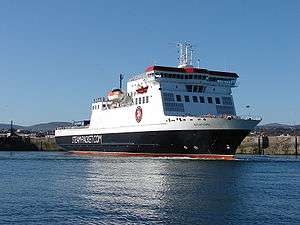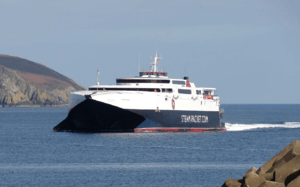MV Moby Love
| Moby Love at Livorno, 2008 | |
| History | |
|---|---|
| Name: |
|
| Owner: |
|
| Operator: |
|
| Port of registry: | |
| Route: |
|
| Ordered: | 24 November 1969 |
| Builder: | Cantieri Navali di Pietra Ligure |
| Yard number: | 12 |
| Laid down: | 1 February 1971 |
| Launched: | 26 February 1972 |
| Completed: | February 1975 |
| In service: | March 1975 |
| Identification: |
|
| Status: | In service as of 2011 |
| General characteristics | |
| Displacement: | |
| Length: | 114.59 m (375 ft 11 in) |
| Beam: | 18.62 m (61 ft 1 in) |
| Draught: | 4.11 m (13 ft 6 in) |
| Installed power: | Two Pielstick 16PC2-2V-400 diesel engines |
| Speed: | 21.8 knots (40.4 km/h) |
| Capacity: | 1,000 passengers, 48 berths, 160 cars. 35 railway wagons or 10 carriages and 11 wagons. |
M/F Moby Love is a passenger ferry currently in service with Moby Lines, Genoa, Italy. She was launched in 1972 as Saint Eloi but not completed until 1975 due to the bankruptcy of the shipyard that built her. She was built as a multi-purpose ferry, capable of carrying railway rolling stock as well as road vehicles.
Built for Angleterre-Lorraine-Alsace, she was renamed Channel Entente in 1989. She served on cross-channel routes until sold in 1990 to the Isle of Man Steam Packet Company (IoMSPCo) and reflagged to the Bahamas. Renamed King Orry, she was reflagged to the Isle of Man in 1995. In 1998, she was sold to Moby Lines and renamed Moby Love, then Moby Love 2. She was renamed Moby Love in 2002 and remains in service under this name.
Description
The ship is 114.59 metres (375 ft 11 in) long, with a beam of 18.62 metres (61 ft 1 in). She has a depth of 11.48 metres (37 ft 8 in) and a draught of 4.11 metres (13 ft 6 in).[1] She is powered by two Pielstick 16PC2-2V-400 diesel engines giving a total power output of 10,740 kilowatts (14,400 hp). These can propel the ship at 21.8 knots (40.4 km/h).[2]
Originally built as a train and roll on, roll off ferry,[1] the ship has 48 berths. She can carry 1,000 passengers and 160 cars. The ship is assessed as 4,649 GRT, 1,849 NRT.[2] She could carry 35 railway wagons or 10 carriages and 11 wagons.[1]
History
Saint Eloi was ordered on 24 November 1969 and her keel was laid on 2 January 1971. Built by Cantieri Navali di Pietra Ligure, Pietra Ligure, Italy, she was yard number 12 and was launched on 26 February 1972. She was due to be delivered in October 1972,[2] but the shipyard went bankrupt after her launch and the unfinished ship was laid up in Genoa.[1] Work resumed on 1 July 1972. The Italian Government had to finance the completion of the ship, which was delivered to ALA in February 1975.[2]

Saint Eloi entered service with ALA on the Dover - Dunquerque route on 12 March 1975.[2] Her port of registry was Dunquerque and the IMO Number 7207451 was allocated. On 23 March 1977, ALA was bought outright by British Rail.[1] As she could carry railway wagons, Saint Eloi was classed as a locomotive, being allocated to Class 99 under TOPS. Saint Eloi was allocated the TOPS number 99 013.
On 27 May 1986, Saint Eloi was chartered for four months by SNCF. She was employed on the Calais - Dover route. She reverted to the Dover - Dunquerque route on 27 September, serving until 24 April 1988 when she was again chartered by SNCF for use between Calais and Dover.[2] On 1 May 1987, Saint Eloi was in collision with Cambridge Ferry just outside Dover Harbour. Both ships damaged. Saint Eloi was repaired at Dunquerque, re-entering service on 16 May.[1] On 23 July 1988, Saint Eloi collided with the breakwater at Dover and suffered a damaged stern.[2] Nord Pas-de-Calais replaced Saint Eloi and Saint Germain on the Calais - Dover route.[3] On 8 January 1989, she entered service on the Larne - Stranraer route. On 4 March 1989, Saint Eloi entered service on the Dún Laoghaire - Holyhead route, which she operated on until 28 April.[2] This enabled the regular ferry St Columba to undergo an overhaul at Bremerhaven, West Germany.[1] On 20 May, Saint Eloi was renamed Channel Entente. She entered service on the Calais - Dover route on 25 May 1989, serving until the end of the year.[2]
On 11 January 1990, Channel Entente arrived at Douglas, Isle of Man for berthing trials. On 5 February 1990 she was reflagged to the Bahamas, with Nassau as her port of registry. The call sign FNKC was allocated.[1] She was sold to Vessel Holdings Ltd, Nassau, on 9 February and then sold to the IoMSPCo, Douglas on 14 February. She entered service on the Douglas - Heysham route on 19 February, serving until 27 September when she was sent to Messrs Wright & Beyer, Birkenhead for a refit.[2] during the refit, her passenger accommodation was extended and vehicle side-loading doors were fitted. An additional bow thruster was fitted.[1] During her time with the IoMSPCo, the rails were filled in and the buffers were removed.[4] On 8 December 1990, Channel Entente was renamed King Orry, she re-entered service on the Douglas - Heysham and Douglas - Liverpool routes on 9 December.[2] King Orry was fitted with stern doors in 1992.[1] In February 1995, King Orry was reflagged to the Isle of Man, with Douglas as her port of registry. Her last day of service with IoMSPCo was 28 September 1998.[2]
In October 1998, King Orry was sold to Moby Lines Srl, Naples, Italy. On 21 October, she was renamed Moby Love. The call sign IBDB was allocated.[1] She departed Birkenhead on 23 October bound for Livorno, arriving on 29 October. Later that year, she was renamed Moby Love 2. She entered service on the Piombino - Portoferraio route in April 1999. She was renamed Moby Love in 2002.[2] Moby Love remains in active service as of 2011. She is allocated the MMSI Number 247322000.[5]
Gallery
 King Orry at Douglas, 1996
King Orry at Douglas, 1996 Moby Love en route to Piombino from Isola d'Elba
Moby Love en route to Piombino from Isola d'Elba
In popular culture
The ship was featured in the 1997 ChuckleVision episode, Loch Aye in which the Chuckle Brothers travel from Heysham to Douglas on board the King Orry thinking they were heading to the Loch Aye Highland games in Scotland (actually the Loch Aye Island Games in the Isle of Man).[6][7]
References
| Wikimedia Commons has media related to Moby Love. |
- 1 2 3 4 5 6 7 8 9 10 11 Thornton, Nigel; Goodfellow, Ray. "Mv Saint Eloi, Channel Entente, King Orry, Moby Love 2, Moby Love". Dover Ferry Photos. Retrieved 9 February 2016.
- 1 2 3 4 5 6 7 8 9 10 11 12 13 "M/S SAINT ELOI." (in Swedish). Fakta om Fartyg. Retrieved 7 January 2010.
- ↑ "NORD PAS-DE-CALAIS". HHV Ferry. Retrieved 7 January 2010.
- ↑ "King Orry V by Bob Ellsmoor ex Chief Officer, IOMSPCo Ltd". Ships of Mann. Retrieved 7 January 2010.
- ↑ "MOBY LOVE". Marine Traffic. Retrieved 7 January 2010.
- ↑ "Loch Aye article". Internet Movie Database. Retrieved 4 June 2014.
- ↑ "Loch Aye plot". Internet Movie Database. Retrieved 4 June 2014.

